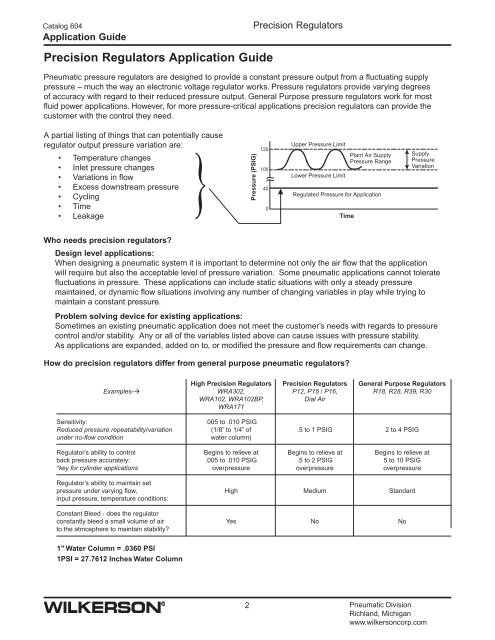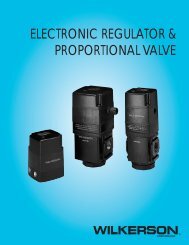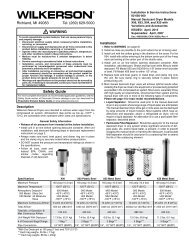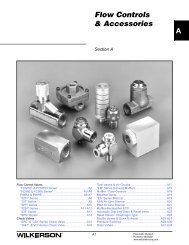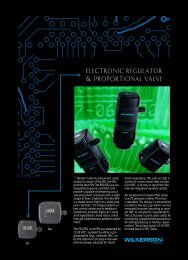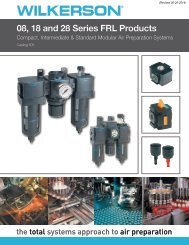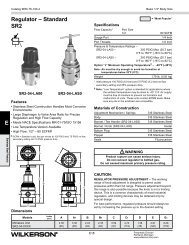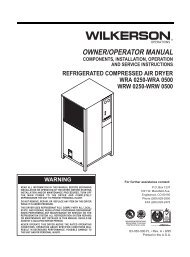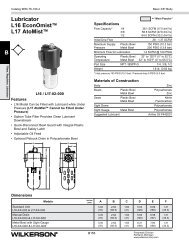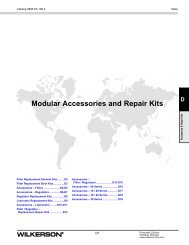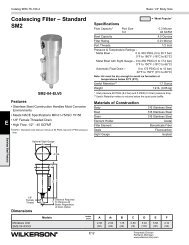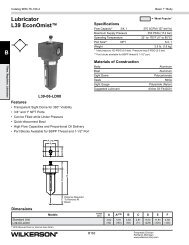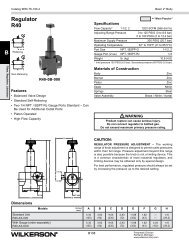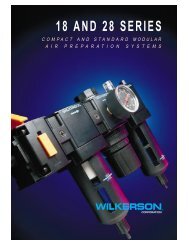Catalog 604: Pneumatic Products - Wilkerson Corporation
Catalog 604: Pneumatic Products - Wilkerson Corporation
Catalog 604: Pneumatic Products - Wilkerson Corporation
You also want an ePaper? Increase the reach of your titles
YUMPU automatically turns print PDFs into web optimized ePapers that Google loves.
<strong>Catalog</strong> <strong>604</strong><br />
Application Guide<br />
Precision Regulators<br />
Precision Regulators Application Guide<br />
<strong>Pneumatic</strong> pressure regulators are designed to provide a constant pressure output from a fluctuating supply<br />
pressure – much the way an electronic voltage regulator works. Pressure regulators provide varying degrees<br />
of accuracy with regard to their reduced pressure output. General Purpose pressure regulators work for most<br />
fluid power applications. However, for more pressure-critical applications precision regulators can provide the<br />
customer with the control they need.<br />
A partial listing of things that can potentially cause<br />
regulator output pressure variation are:<br />
• Temperature changes<br />
}<br />
• Inlet pressure changes<br />
• Variations in flow<br />
• Excess downstream pressure<br />
• Cycling<br />
• Time<br />
• Leakage<br />
Pressure (PSIG)<br />
120<br />
100<br />
40<br />
0<br />
Upper Pressure Limit<br />
Lower Pressure Limit<br />
Regulated Pressure for Application<br />
Time<br />
Plant Air Supply<br />
Pressure Range<br />
Supply<br />
Pressure<br />
Variation<br />
Who needs precision regulators?<br />
Design level applications:<br />
When designing a pneumatic system it is important to determine not only the air flow that the application<br />
will require but also the acceptable level of pressure variation. Some pneumatic applications cannot tolerate<br />
fluctuations in pressure. These applications can include static situations with only a steady pressure<br />
maintained, or dynamic flow situations involving any number of changing variables in play while trying to<br />
maintain a constant pressure.<br />
Problem solving device for existing applications:<br />
Sometimes an existing pneumatic application does not meet the customer’s needs with regards to pressure<br />
control and/or stability. Any or all of the variables listed above can cause issues with pressure stability.<br />
As applications are expanded, added on to, or modified the pressure and flow requirements can change.<br />
How do precision regulators differ from general purpose pneumatic regulators?<br />
High Precision Regulators Precision Regulators General Purpose Regulators<br />
Examples- WRA302, P12, P15 / P16, R18, R28, R39, R30<br />
WRA102, WRA102BP,<br />
Dial Air<br />
WRA171<br />
Sensitivity:<br />
.005 to .010 PSIG<br />
Reduced pressure repeatability/variation (1/8” to 1/4” of .5 to 1 PSIG 2 to 4 PSIG<br />
under no-flow condition<br />
water column)<br />
Regulator’s ability to control Begins to relieve at Begins to relieve at Begins to relieve at<br />
back pressure accurately: .005 to .010 PSIG .5 to 2 PSIG 5 to 10 PSIG<br />
*key for cylinder applications overpressure overpressure overpressure<br />
Regulator’s ability to maintain set<br />
pressure under varying flow, High Medium Standard<br />
input pressure, temperature conditions:<br />
Constant Bleed - does the regulator<br />
constantly bleed a small volume of air Yes No No<br />
to the atmosphere to maintain stability?<br />
1" Water Column = .0360 PSI<br />
1PSI = 27.7612 Inches Water Column<br />
2<br />
<strong>Pneumatic</strong> Division<br />
Richland, Michigan<br />
www.wilkersoncorp.com


